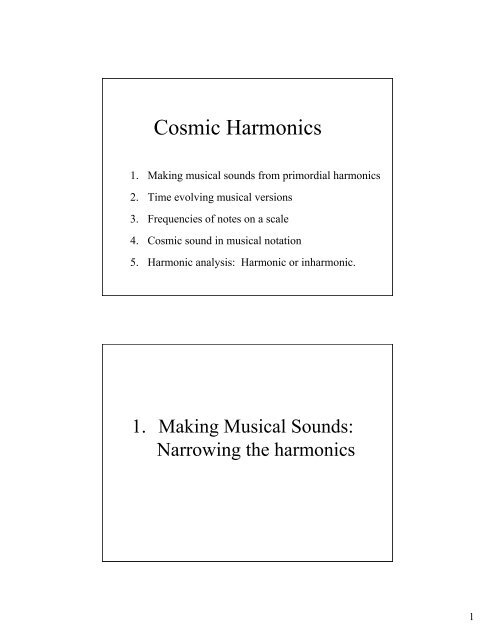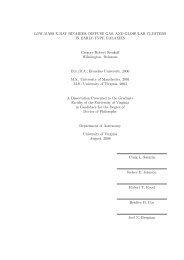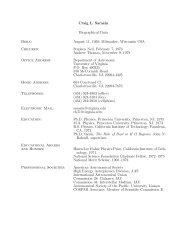Cosmic Harmonics
Cosmic Harmonics
Cosmic Harmonics
You also want an ePaper? Increase the reach of your titles
YUMPU automatically turns print PDFs into web optimized ePapers that Google loves.
<strong>Cosmic</strong> <strong>Harmonics</strong><br />
1. Making musical sounds from primordial harmonics<br />
2. Time evolving musical versions<br />
3. Frequencies of notes on a scale<br />
4. <strong>Cosmic</strong> sound in musical notation<br />
5. Harmonic analysis: Harmonic or inharmonic.<br />
1. Making Musical Sounds:<br />
Narrowing the harmonics<br />
1
Why does it sound so “unmusical”?<br />
Because the Universe is not a good resonator<br />
the harmonics are broad (fuzzy)<br />
we do not easily notice the hidden notes<br />
Compare the Universe with a flute:<br />
Universe<br />
P(k)<br />
C(ℓ)<br />
decibel scales<br />
fundamental<br />
Flute<br />
h a r m o n i c s<br />
2
8<br />
A “broad” note sounds quite different from a pure tone<br />
The difference seems greatest for the lowest note.<br />
What’s the Chord ?<br />
}<br />
Between major & minor 3 rd<br />
Single tone<br />
Pure sine wave<br />
Spread of tones<br />
~200 Hz range<br />
C(ℓ) as observed<br />
P(k) undistorted<br />
P(k) pure tones<br />
3
8<br />
kHz<br />
4<br />
2. Evolving Musical Versions<br />
Primordial Sound Spectrum: First 400,000 yrs<br />
There are fuzzy harmonics !!<br />
0<br />
BB 1<br />
2<br />
× 100,000 years<br />
3<br />
4<br />
4
8<br />
kHz<br />
4<br />
0<br />
8<br />
kHz<br />
4<br />
0<br />
Make the cosmic harmonics pure<br />
BB 1<br />
2<br />
× 100,000 years<br />
3<br />
4<br />
Combine raw and clean sounds<br />
BB 1<br />
2<br />
× 100,000 years<br />
3<br />
4<br />
5
8<br />
kHz<br />
4<br />
0<br />
8<br />
kHz<br />
10 2<br />
22 kHz<br />
4<br />
0<br />
10 2<br />
Repeat with exponential time:<br />
100 yrs → 10 million yrs<br />
103 104 105 106 107 years<br />
Pure <strong>Harmonics</strong><br />
103 104 105 106 107 years<br />
6
8<br />
kHz<br />
4<br />
0<br />
10 2<br />
Combine real & pure harmonics<br />
103 104 105 106 107 years<br />
3. Note Frequencies<br />
7
Notes on a Scale<br />
Our “tempered” scale is multiplicative<br />
Frequency (Hz)<br />
1000<br />
500<br />
300<br />
100<br />
♪<br />
♪<br />
♪<br />
1000 600 200 Hz<br />
3520<br />
×2<br />
1760<br />
×2<br />
880<br />
×2<br />
440<br />
×2<br />
220<br />
110<br />
×2<br />
×2<br />
55<br />
27.5<br />
×2<br />
7 octaves on A<br />
Notes within the Octave<br />
• 12 semitones make an octave: f 13 /f 1 = 2.00<br />
A A # B C C # D D # E F F # G G #<br />
B ь D ь E ь G ь A ь<br />
• From one to the next is the same frequency ratio<br />
f 2 /f 1 = f 3 /f 2 = f 4 /f 3 ……… f 12 /f 11 = q<br />
•Now, f 2 /f 1 ×f 3 /f 2 ×f 4 /f 3 ……… × f 13 /f 12 = f 13 /f 1 = 2<br />
so q 12 = 2 q = 2 1/12 = 1.0569…<br />
and f n = f 1 ×q n/12 = f 1 × (1.0569…) n<br />
8
Microtonal & Tempered Notes<br />
• Microtonal: notes are allowed to have any frequency<br />
• Tempered: notes are forced to nearest note on scale<br />
which note, n, corresponds to frequency f ?<br />
f n/f 1 = 2 n/12<br />
log (f n/f 1) = (n/12) log 2<br />
n = 12 log (f n/f 1) / log 2 = 39.8631 × log 10 (f n/f 1)<br />
•egfor 6 th harmonic on a string: f n = 6 × f 1 f n/f 1 = 6<br />
n = 39.8631 × log 10 (6) = 31.0196<br />
which is 7.0196 notes above the 24 th<br />
ie 7.0196 notes into the third octave.<br />
we force this to the 7 th note (G above C in 3 rd octave)<br />
4. <strong>Cosmic</strong> Sound in Musical<br />
Notation<br />
9
microtonal tempered<br />
The Opening Crescendo<br />
4×10 5 yrs<br />
raw<br />
pure<br />
both<br />
10
microtonal<br />
tempered<br />
one octave<br />
Creation’s Opening Chord<br />
All sounds: 10 4 –10 6.5 years<br />
exponential time<br />
constant volume<br />
Chord Analysis<br />
raw<br />
pure<br />
both<br />
11
open<br />
f 1<br />
2×f 1<br />
3×f 1<br />
closed<br />
f 1<br />
3×f 1<br />
5×f 1<br />
5. Harmonic Analysis<br />
Harmonic Vibrations: f n = n×f 1<br />
Column of air<br />
Strings<br />
1<br />
2<br />
3<br />
4<br />
5<br />
6<br />
12
Perfectly Harmonic Notes<br />
• Many musical instruments have simple harmonic sequences<br />
e.g. strings & air columns: f n = n × f 1<br />
An integral number of waves fit between the two ends<br />
1 2 3<br />
4<br />
5 6<br />
7<br />
8<br />
9 10 11 12 13 14 15 16 17 18 19<br />
Flute<br />
• We “hear” the pitch of f 1 while the relative strength of all<br />
the harmonics gives the “quality” or “color”<br />
Inharmonic Notes<br />
• Some instruments have more complex modes of vibration<br />
e.g. drums, bells, bars:<br />
• Sometimes, hear a “ghost strike tone” – not actually present<br />
some partials are harmonically related (f = nf s)<br />
We hear f s even if f s isn’t itself present<br />
• What is the primordial sound?<br />
It is basically harmonic, but 1 st and 2 nd are inharmonic<br />
A ghost strike tone defined by the higher partials<br />
13
Complex Vibrations<br />
Bells Cymbals<br />
1<br />
2<br />
3<br />
4<br />
5<br />
e.g. bells & cymbals: complex modes<br />
usually not harmonic<br />
structure adjusted more harmonic<br />
The ghost strike tone<br />
A bar vibrates with mode frequencies: F m = (2m+1) 2<br />
this is not harmonic in m (it is quadratic)<br />
however; m=4,5,6 are in ratios 81:121:161 ≈ 2:3:4<br />
Our ear hears the “ghost” fundamental at 1 = strike tone<br />
1<br />
2<br />
3<br />
4 56<br />
14
Primordial <strong>Harmonics</strong><br />
• What kind of harmonics does the primordial sound have?<br />
It is basically harmonic, but 1st and 2nd are inharmonic<br />
A ghost strike tone is defined by the higher partials<br />
1<br />
Low Pitch<br />
Inharmonic Fundamental<br />
2<br />
3<br />
4<br />
Primordial <strong>Harmonics</strong><br />
Ghost strike tone<br />
at f s = f n / n<br />
5<br />
6<br />
raw/pure<br />
pure/even-f 1<br />
pure/even-f S<br />
7<br />
8<br />
High Pitch<br />
15
10<br />
Reduced <strong>Harmonics</strong> & the Strike Tone<br />
microtonal tempered<br />
16





